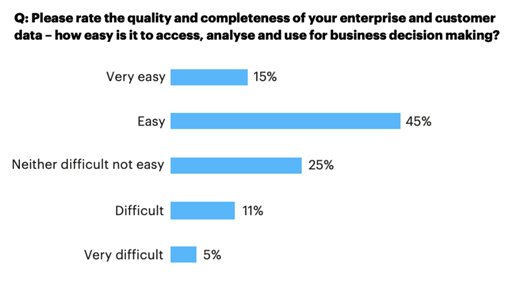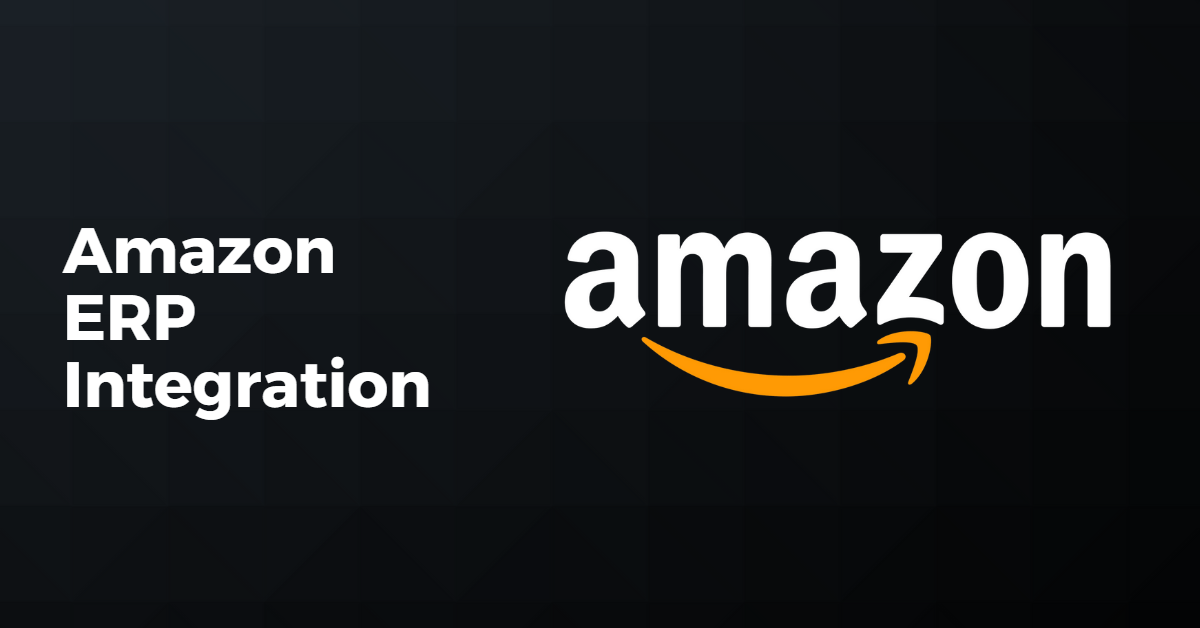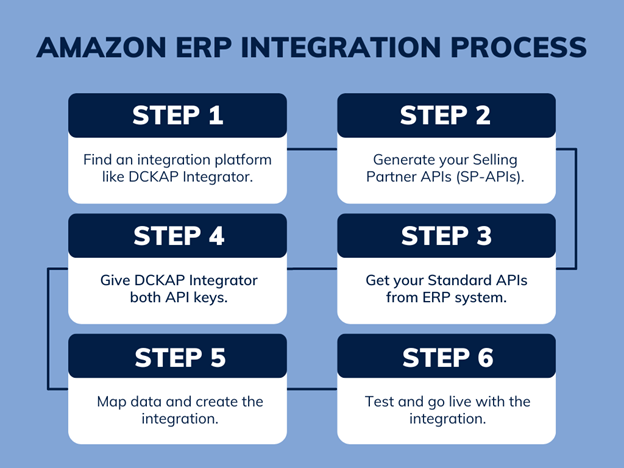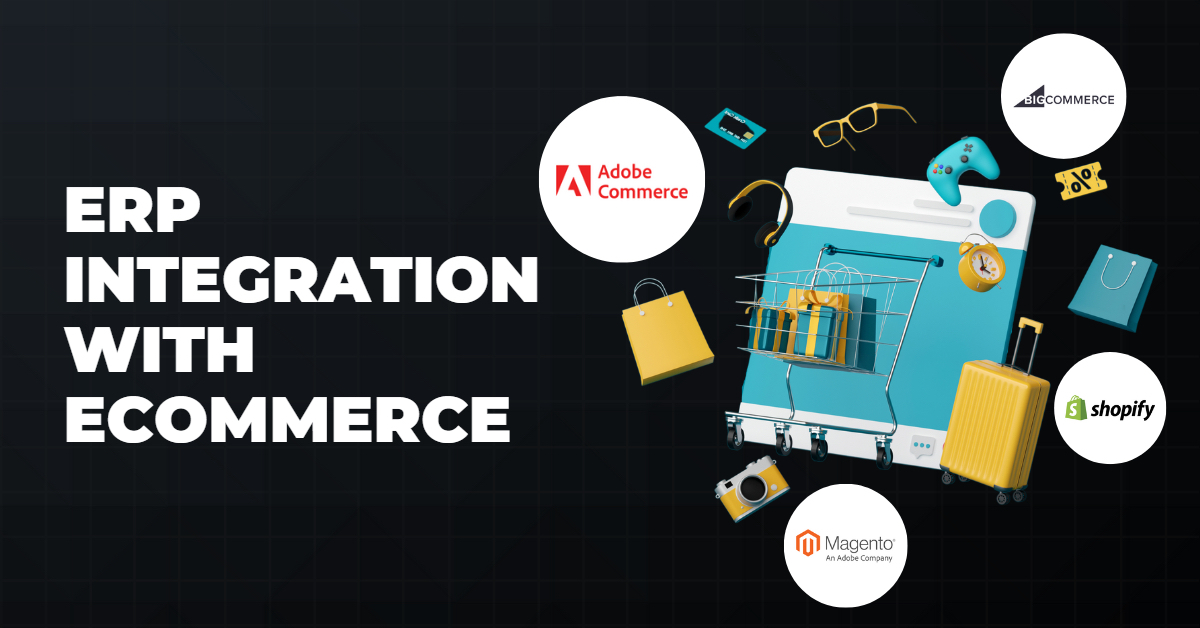For enterprise brands and wholesalers with high-volume Amazon sales, connecting Amazon to their ERP solution is essential. This is especially true for companies with complex backends.
Integration is also critical for Amazon stores that use FBA (Fulfillment by Amazon). FBA is a service that allows companies to store their products in Amazon’s fulfillment centers and let Amazon handle the shipping to customers. FBA is popular with companies that want to save time on fulfillment or take advantage of Amazon’s Prime shipping.
Methods Of Amazon ERP Integration
There are two main methods to integrate Amazon with your ERP system. Let’s break them down:
1. Custom API Integration
This method involves building a direct connection between Amazon and your ERP (Enterprise Resource Planning system) using APIs. With this approach, you create custom code that allows the two systems to talk to each other and share data. The biggest advantage here is flexibility, you can tailor the integration to meet your specific business needs.
However, significant technical knowledge is required within your team. You’ll need developers who can build, maintain, and update the integration as needed. While it gives you complete control, it can be time-consuming and harder to scale in the long run.
2. iPaaS or Middleware Tools
This is the simpler and more scalable option. Using an iPaaS (Integration Platform as a Service) or middleware tool, you can connect Amazon and your ERP software without building anything from scratch. These tools handle the data flow between your various systems, automating processes like order management, inventory updates, and financial reporting.
Plus, you don’t need a lot of technical expertise, everything is taken care of by the service provider. iPaaS tools are also easier to scale as your business grows, making them a great choice for long-term efficiency.
Both methods work, but the best one for you depends on your business needs, technical resources, and growth plans.
Step-by-Step Guide For Amazon ERP Integration With iPaaS
To understand how Amazon ERP Integration works, we have taken DCKAP Integrator iPaaS to showcase the process clearly. Here’s a comprehensive guide on how you can get started with this integration:
1. Find an integration platform
Start by finding an Integration Platform as a Service (iPaaS). With an iPaaS like the DCKAP Integrator, you can design workflows that connect your apps to Amazon without installing or managing hardware.
2. Get your Selling Partner APIs from AWS
Next, you’ll need to create an AWS profile in your Amazon Seller Central account. Then create your Selling Partner APIs (SP-APIs).
DCKAP Integrator gets access to these APIs from Amazon. They allow you to programmatically access data on orders, shipments, payments, and more.
3. Get APIs for your ERP
Get your ERP provider’s Standard APIs next. For example, if you use NetSuite, you’ll need to set up a Rest API integration in the administration dashboard.
4. Give DCKAP Integrator both API keys
Once the DCKAP Integrator has both APIs, it maps out how data will flow between your ERP system and Amazon. By doing this, you’ll make sure the data in each system is formatted correctly.
5. Make the integration
Once you have your data mapping in place, you can start building your integration. DCKAP Integrator periodically schedules data updates from one system to another, keeping your system up to date.
For instance, you can add a New Customer to specific contacts in your CRM. Then sync the tag to your email marketing software to start a welcome campaign.
6. Go live with the integration
Test your integration once you’ve built it to ensure it works. Trial both the technical aspects of the integration and the business processes that will be impacted.
Make sure to involve all relevant stakeholders in the testing process so that everyone understands what to expect.
You can go live with your Amazon ERP integration once it’s perfect.
Top Systems To Integrate With Amazon
Amazon doesn’t just work well with ERP systems; it can connect with other software to simplify your operations. Here’s a breakdown of some key integrations that can make life easier for manufacturers and distributors:
CRM Systems
You can integrate Amazon with your Customer Relationship Management (CRM) system. This allows you to keep track of every customer interaction and order in one place. When a customer places an order on Amazon, their details can flow directly into your CRM. This means you can easily follow up with personalized offers, updates, or support. It’s a simple way to build loyalty and increase repeat business.
Inventory Management Software
Managing inventory is a big deal for manufacturers and distributors. Connecting Amazon with your inventory management system means you can track stock levels in real time. It ensures you never overpromise on availability or run out of high-demand items. Plus, you can automate reordering when stock runs low, saving time and avoiding delays.
Accounting Software
Amazon can also link to your accounting tools like QuickBooks or Xero. This integration helps you manage finances by syncing order data, expenses, and revenue streams automatically. Instead of juggling numbers manually, you’ll get accurate records for better cash flow management. For manufacturers and distributors, this means fewer mistakes and smoother audits.
Shipping and Logistics Platforms
If you use shipping tools like ShipStation or FedEx Manager, integrating them with Amazon makes fulfillment a breeze. As soon as an order comes in, shipping labels and tracking numbers can be generated instantly. It ensures faster deliveries, happier customers, and fewer bottlenecks in your supply chain.
eCommerce Platforms
For those who sell on multiple sales channels, linking Amazon with platforms like Shopify or Magento can centralize your operations. You can manage listings, orders, and customer data in one place. This is a game-changer for distributors who want to expand their reach without adding more workload.
Warehouse Management Systems (WMS)
Amazon integration with WMS lets you streamline operations inside your warehouse. Orders from Amazon flow directly into your system, so your team can pick, pack, and ship more efficiently. It reduces errors and speeds up the entire process, which is essential for meeting tight deadlines.
What Are The Benefits Of Amazon ERP Integration?
Automate selling processes
Some 47% of IT leaders say the greatest ROI from automation occurs within operations. When you integrate Amazon with your backend operations, you can automate many of your selling processes.
For example, you can automatically list products on Amazon from your inventory management system or update product prices on Amazon based on changes in your accounting system.
Improve ecommerce data
Amazon sends sellers a lot of data, like in-demand products, customer demographics, and shipping information. With an integrated system, you can use this data to improve offerings and sell more products.
Accenture’s 2020 ERP report found that nearly 40% of chief information officers (CIOs) find it challenging to access or use company data for decision-making.
 Source: Accenture
Source: Accenture
ERP integration with Amazon makes it possible to centralize and improve ecommerce data, creating a central hub where all stakeholders can access it.
Faster order processing
A wholesale company that integrates its ERP with Amazon can process orders faster and more efficiently. By synchronizing their inventory data with Amazon, they can automatically update stock levels and prices, ensuring orders are always on point.
It also saves time and reduces errors because you don’t have to enter data manually. Additionally, Amazon ERP integration lets wholesale companies see order status and shipping info in real time.
Free up resources
One study found that 70% of back-office executives look for advanced automation in an ERP. Amazon ERP integration facilitates automated data exchange between Amazon and your backend systems, eliminating costly manual efforts.
For example, a smart ERP system can pass information about:
- Order management
- Customer data
- Shipping details
- Accounting systems
- Product and price information
- Inventory counts
- Purchase orders
Automation helps scale innovation. Amazon ERP integration combined with technologies such as artificial intelligence offers nearly limitless possibilities for improving business processes.
Amazon ERP Integration: Best Practices
Whether it’s your first or fifth ERP integration, here are a few best practices to keep in mind:
Make an integration plan
Create a plan with your team before you integrate with Amazon
Lead the project with someone who understands your business goals and internal processes. Prepare for any obstacles that may arise by working with stakeholders.
When creating your plan, think about:
- Why do you want to integrate your ERP system with Amazon?
- What information do you want to send from Amazon to ERP?
- Where are the gaps in your inventory data?
- What other systems need to be integrated, and how will those integrations work?
By planning ahead, you can implement an efficient integration and reduce the chances of failure.
Inform stakeholders about the changes
Integrating Amazon into an older, legacy system may cause resistance and change. Changing organizational processes, roles, or other aspects of a company’s operation could cause pushback or roadblocks.
Even organizations using newer, cloud-based ERP systems (e.g., Acumatica) may undergo changes in their processes. They may find that current processes need to be adapted to accommodate the Amazon integration and specific workflows.
Overall, it’s crucial to communicate throughout the integration process and keep members on the same page.
Provide training to relevant parties
Once you’ve tested and are confident that the integration is ready, it’s important to provide training to all relevant parties.
This will ensure that everyone knows how to use the new system and understands the impact that it will have on their day-to-day work. By planning, testing, and training, you can ensure a successful Amazon ERP integration.
Choosing The Right ERP Integration Solution
Here are the key factors to keep in mind when you are selecting an ERP Integration tool:
Compatibility with Your ERP and Other Systems
Ensure the tool works seamlessly with your existing ERP system and the other platforms you want to integrate, such as eCommerce, CRM, or logistics solutions. Compatibility is especially critical for avoiding disruptions and ensuring smooth communication between systems.
Ease of Use
The tool should be straightforward to implement without requiring extensive downtime or heavy technical expertise. A smooth onboarding process can save you time and effort.
Scalability
Your business will evolve, and so will your integration needs. Pick a tool that can grow with your operations, whether you’re expanding to new marketplaces, adding business units, or scaling production.
Real-Time Data Sync
Real-time synchronization ensures that your inventory levels, order statuses, and customer data are always accurate and up-to-date, reducing errors and improving decision-making.
Customization Options
A good integration tool should offer flexibility to cater to your unique business processes and workflows. Look for tools that allow custom mapping of data fields and rules to match your specific requirements.
Cost-Effectiveness
Evaluate the overall cost, including setup fees, subscription charges, and any hidden costs. Compare this against the ROI the tool can provide, such as time saved, fewer manual errors, and improved efficiency.
Support for Multi-Platform Integration
If your business operates across multiple platforms (like Amazon, Shopify, or other marketplaces), choose a tool that can integrate all your systems into a single cohesive ecosystem.
Robust Customer Support
Reliable support is a must for resolving any issues quickly. Look for tools that offer 24/7 assistance, comprehensive documentation, and responsive customer service.
Data Security and Compliance
Ensure the tool adheres to industry security standards and compliance regulations, especially if your business handles sensitive data like customer details or financial information.
Proven Track Record
Check for case studies, reviews, or testimonials from businesses similar to yours. This will give you insights into the tool’s performance and reliability in real-world scenarios.
Try Amazon ERP Integration With DCKAP Integrator
If you’re looking for a simple, efficient, and scalable way to integrate your ERP system with Amazon, DCKAP Integrator is the perfect solution. It has integrated nearly all the popular ERPs for manufacturers and distributors.
With this tool, you can maximize the value of your Amazon marketplace and ERP system without the complexities of integration. It’s a smart, affordable, and reliable iPaaS tool that helps manufacturers, distributors, and retailers achieve seamless operations.
Here’s why DCKAP Integrator stands out:
- Hassle-Free Integration: Whether you use Epicor, Infor, NetSuite, Sage 200, SAP Business One, or another ERP, DCKAP Integrator seamlessly syncs your data for real-time accuracy.
- Bi-Directional Data Sync: It ensures that information flows smoothly between Amazon and your ERP, keeping inventory, orders, and customer data always up to date.
- Customizable for Your Needs: Unlike rigid connectors, DCKAP Integrator adapts to your specific business requirements, giving you the flexibility to scale as you grow.
- Ease of Use: You don’t need a technical team to manage the integration. DCKAP’s user-friendly interface and expert support make setup and maintenance a breeze.
- Improved Efficiency: With automated order processing, inventory updates, and real-time reporting, your team can focus on what matters, delivering excellent customer experience.
If you are curious to know more about DCKAP Integrator, try a demo today!
FAQs
What is Amazon ERP integration?
Amazon ERP integration connects your ERP system with Amazon Business. For Amazon FBA sellers, integration with an ERP system automates inventory management, order processing, and shipping updates. This saves time by eliminating manual tasks and helps businesses take full advantage of Amazon’s Prime shipping and fulfillment services.
Which ERP systems can Amazon be integrated with?
Some top ERP software Amazon integrates with include:
- Microsoft Dynamics 365
- NetSuite
- Oracle E-Business Suite
- SAP Business One
- SAP S/4HANA
- SYSPRO
- Acumatica
What major challenges does Amazon ERP integration solve for sellers?
- Manual data entry issues: Automates processes to save time and reduce errors.
- Inventory mismanagement: Provides real-time stock updates and accurate inventory levels.
- Delayed order processing: Speeds up order and shipping workflows.
- Cash flow tracking problems: Integrates financial data for better cost management.
Which ERP systems work best with Amazon?
Amazon integrates well with ERP systems like NetSuite, SAP Business One, Sage 200, Epicor, and Infor. Each offers advanced features for managing inventory, finance, human resources, and site operations, depending on the size and needs of the business.
How does Amazon ERP integration improve business intelligence?
By syncing Amazon data with your ERP, you gain actionable insights into sales trends, user behavior, and high-demand items. These insights allow businesses to make informed decisions and optimize their sales channels.
Contents





